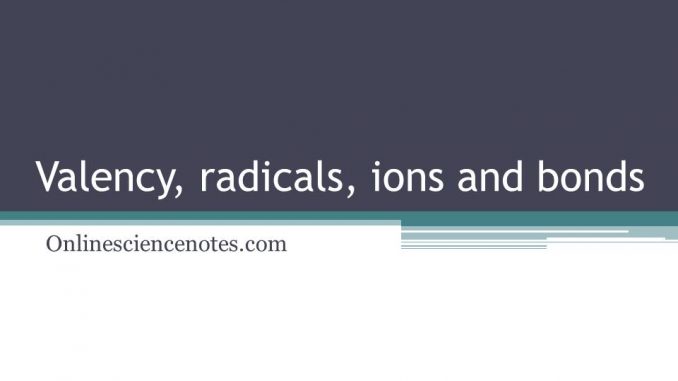
Valency: Combining capacity of an element or a radical with another element or radical to form a compound or molecule
- Total number of electrons lost, gained, or shared by an atom during chemical combination gives its valency
HOW to find the valency of elements?
- For group I to IV, Valency = V.E’s number
- For group V to VIII, Valency = 8- V.E’s number
- Valency of a radical = Number of charges present
- For Transition elements, there are two incomplete outer shells, so the electrons of these two shells participate in bonding and thus show Variable Valencies.
- “-ous” suffix = lower valency
- “-ic” suffix = higher valency g. Cuprous (Cu+) = valency 1 , Cupric (Cu++)= valency 2
Radicals: Charged atoms or group of atoms having a common charge which act as a single unit during a chemical reaction.
- Highly reactive & unstable chemical species
- Don’t occur in free form & make different types of compounds
- On the basis of Charge:
- Electropositive or Basic Radical: K+, Mg++, Al+++,Si++++
- Electronegative or Acidic Radical: F–,O—,NO3–,CO3– –
- On the basis of Composition:
- Simple Radical: consists only one atom e.g. Na+, Zn++, B+++,Cl–,N—
- Compound Radical: consists of a group of atoms of different elements e.g. NO3–,CO3– –, NH4+
- Can pass into or out of a compound as a unit without undergoing decomposition
Ions: The charged particle formed when an atom gains or loses electron
- Cations: ion formed when Metal atom loses electron and acquire positive charge. e.g. Ag+, Ca++, B+++, H+(exception)
- Anions: ion formed when Non-Metal atom gains electron and acquire negative charge. e.g. Br–, O– –, N– – –
Inert or Noble Gases: Elements which have eight electrons in their valence shell (except He=has 2 electrons) & do not take part in chemical bonding e.g. He, Ne, Ar, Kr, Xe, Rn
- Fall in the Group O(VIIIA or 18) and are chemically inert because of their stable electronic configuration
- Duplet State: presence of two electrons in the K-shell of an atom with single shell e.g. He
- Duplet Rule: the tendency of an atom with single shell to acquire two electrons in its K-shell
e.g. H(1)+1e– —–>H–(2)
Li (2,1) —–>Li+(2) +1e–
- Octet State: presence of eight electrons in the outermost shell or valence shell of an atom e.g. Ne, Ar, Kr etc.
- Octet rule: the tendency of an atom to acquire eight electrons in its valence shell by gaining, losing or sharing electrons between the combining atoms during the formation of molecule
e.g. Na(2,8,1) —–>Na+(2,8) +1e–
Cl(2,8,7) + 1e– —–>Cl–(2,8,8)
Cause of Chemical reaction: losing, gaining, sharing of electrons by an atom to acquire the stable electronic configuration
Chemical Bond: The force of attraction by which atoms or group of atoms are combined to form a stable molecule or compound is called chemical bond.
- Types:
Electrovalent or Ionic Bond: the chemical bond formed by the transfer of electron(s) from the valence shell of metal to the valence shell of non-metal
- The compound formed as a result of electrovalent bonding are called electrovalent compounds. e.g. NaCl, MgCl2,CaO etc.
- The force of attraction between these opposite charges is called electrostatic force of attraction.
- Characteristics of Electrovalent Compounds:
- They are found in solid state.
- They have high boiling and melting point.
- They conduct electricity in molten state or aqueous solution.
- They are soluble in water but insoluble in organic solvents.
- They contain metal atom(s) in their molecule.
Covalent bond: the chemical bond formed by the mutual sharing of electrons between two or more non-metal atoms e.g. CO2, NH3, H2O, CH4
- Represented by a line (-) in between the bonded atoms.
- Characteristics of Covalent Compounds:
- They are found in solid, liquid and gaseous state.
- They have low melting and boiling points in comparison to electrovalent compounds.
- They do not conduct electricity.
- They are insoluble in water but soluble in organic solvents.
- They do not contain metal in them.
Molecular formula: indicates the symbolic representation of the molecule of an element or a compound in molecular form
- Gives the information about the total number of atoms of different elements in a molecule.
- g. Cl2 represents 1 molecule of chlorine while 2Cl represents 2 atoms of chlorine.
- NH3 represents 1 molecule of ammonia & 2NH3 represents 2 molecules of ammonia.
Information obtained from Molecular formula:
- Represents the percentage composition of each element present in the given compound
- Represents one molecule of the substance
- Tells about the number of atoms of each element present in one molecule of the compound
- Helps to know about the molecular weight of the substance
e.g. molecular formula of ammonia is NH3, So its molecular weight=1X14+3X1 = 17 amu
How to write Molecular Formula?
- The symbol of basic(positive) and acidic(negative) radicals are written side by side
- The valency of each radical are written on upper right corner of each
- The valency of the radicals are exchanged. The H.C.F is taken to get a simple whole number.
- The radicals with exchanged valency are combined.
- If a compound radical takes part in the molecular formula, the radical is enclosed in bracket and the valency number is written at the bottom of the formula.
| SYMBOL | MOLECULAR FORMULA |
| Abbreviation of full name of an element | Symbolic representation of a molecule |
| Represents one atom of an element | Represents one molecule of an element or compound |
| Written according to English or Latin name of an element
e.g. symbol of oxygen is O |
Written with the help of symbols and valencies of the elements
e.g. molecular formula of oxygen is O2 |
Author: Sulaksha Purna Shrestha
Valency, Radicals, Ions and Bonds